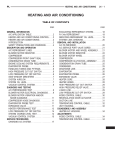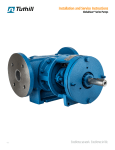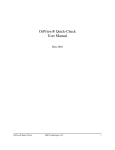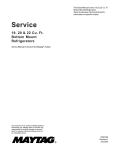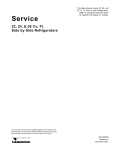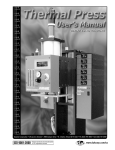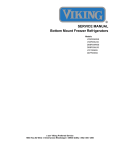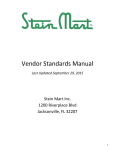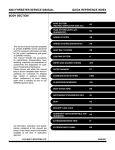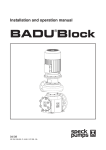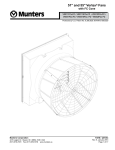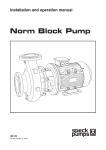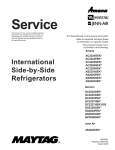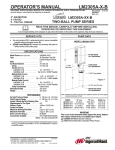Download Lineshaft Conveyor
Transcript
735 INDUSTRIAL LOOP ROAD NEW LONDON WI 54961 920-982-6600 800-558-3616 Toll Free 920-982-7750 FAX E-MAIL: [email protected] Website: www.titanconveyors.com Lineshaft Conveyor INSTALLATION, MAINTENANCE AND PARTS MANUAL For additional copies of this manual, please visit our website at www.titanconveyors.com. Go to Info Center, Select the Maintenance Manual tab and select the manual for your model conveyor. http://www.titanconveyors.com/info-center#823236-maintenance-manuals SERIAL NO. Go to Table of Contents (A) Seller warrants that the material in and the workmanship on the equipment manufactured by TITAN will be free from defects at time of shipment. If during the first year from the date of shipment, the Buyer establishes to the seller’s satisfaction that any part or parts manufactured by TITAN were defective at the time of shipment, TITAN will, at its own expense, repair or replace (but not install) replacement parts. For a time purpose of this warranty, one year will constitute 2080 hours of operation based on an 8 hour day. Sellers liability under this warranty is limited to replacement parts only and the seller will make no allowance for corrective work done unless agreed to by the seller in writing. Charges for correction of defects by others will not be acceptable, unless so authorized in writing, prior to the work being performed, by an officer of the company. Damage caused by deterioration due to extraordinary wear and tear (including, but not in limitation, use said equipment to handle products of a size, weight and shape or at speeds or methods which differ from information originally provided), chemical action, wear caused by the presence of abrasive materials or by improper maintenance or lubrication or improper storage prior to installation, shall not constitute defects. Failure to install equipment properly shall not constitute defects. Warranty does not cover consumable items. (B) Seller has made no representation, warranties, or guarantees, expressed or implied, not expressly set forth on above paragraph. Seller shall not be liable hereunder for any consequential damages included but not in limitation, damages which may arise from loss of anticipated profits or production or from increased cost of operation or spoilage of material. (C) The components used in manufacture of said equipment which were manufactured by others will carry such manufacturers’ customary warranty, which seller will obtain for buyer upon request. (D) No representative of TITAN has been conferred with any authority to waive, alter, vary or add to the terms of warranty state herein, without prior authorization in writing executed by an officer of the company. (E) The foregoing is in lieu of any and all other warranties, expressed or implied, or those extending beyond the description of the product. 2 Go to Table of Contents 7/15 GJH TITAN LINESHAFT MANUAL Table of Contents Page 2................................................................................................................................. Warranty Page 3....................................................................................................................Table of Contents Page 4.............................................................................................................. Safety/Safety Decals Page 5.............................................................................................................................Introduction I. Receiving and Unpacking Page 6.........................................................................................Return Goods Authorization Policy Inventory and Identification of Parts Typical Loose Parts Page 7........................................................................................................................II. Installation Introduction to Lineshaft Conveyors LSR concepts Page 8..................................................................................................................Preparation of Site General Proceedures Page 9..................................................................................................................Support Assemblly Floor Supports Page 10......................................................................................................................... Knee Braces Connecting Brackets Page 11................................................................................................................... Ceiling Mounting Multiple Deck Supports Page 12........................................................................................................................ Straight Beds Drive Shaft Coupling Chain Page 13.................................................................................................................................. Curves 90 Degree Belt Transfer Page 14.................................................................................................................. 30 Degree Divert Page 15....................................................................................................Powered Merge Assembly Page 16.................................................................................................................................... Spurs Powered Gate Assembly Page 17....................................................................................................................Brake Assembly Page 18.......................................................................................................Air Operated Blade Stop Page 19........................................................................................................................... Crossovers Page 20.................................................................................................................................. Rollers Roller Installation Page 21.......................................................................................................................Safety Guards Siderails Adjustable Channel Siderail Page 22..........................................................................................................................Belt Splicing Electrical Page 23...........................................................................................................Final Assembly Check Commissioning III. Maintenance Motors Page 24...............................................................................................................................Reducers Page 26................................................................................................................................Bearings Chains & Sprockets Page 27......................................................................................................... Maintenance Schedule Troubleshooting Page 28..........................................................................................................Troubleshooting Guide Page 30....................................................................................................... LSR Replacement Parts Page 31............................................................................................... Lineshaft Blow Apart Drawing Page 32.............................................................................. Lineshaft 900 Curve Blow Apart Drawing Page 33..............................................................................Lineshaft 450 Merge Blow Apart Drawing Page 34............................................................................................. Lineshaft Pop-up Belt Transfer 3 Go to Table of Contents 7/15 GJH Safety The Safety alert symbol is used with the signal words DANGER, WARNING and CAUTION to alert you to safety messages. They are used in safety decals on the unit and with proper operation and procedures in this manual. They alert you to the existence and relative degree of hazards. Understand the safety message. It contains important information about personal safety on or near the conveyor. DANGER POTENTIALLY HAZARDOUS SITUATION which if not avoided, could result in death or serious injury. WARNING POTENTIALLY HAZARDOUS SITUATION which if not avoided, may result in minor or moderate injury. It may also be used to alert against unsafe practices. CAUTION POTENTIALLY DESTRUCTIVE SITUATION which if not avoided, may result in damage or reduce the longevity of the equipment. ! ! ! Safety Decals ALWAYS replace missing or damaged Safety Decals. Operational Safety Keep Hands, feet, hair and loose clothing away when conveyor is running NEVER climb, sit, walk or ride on conveyor ALWAYS lock out power before servicing to avoid electrical shock. ALWAYS keep hair and loose clothing away. ALWAYS keep hands away from conveyor while moving. Never run conveyor without guards in place. 4 Go to Table of Contents 7/15 GJH WARNING TO PREVENT SERIOUS INJURY NEVER Start Conveyor until Personnel are Clear NEVER Run Conveyor with Guard Off NEVER Attempt Maintenance or Repair While Conveyor is Running NEVER Place Hands by Belt Pulleys or Sprockets While Conveyor is Running NEVER Allow Personnel to Rest or Walk on Conveyor NEVER Wear Loose Fitting Clothing, Gloves, Rings, Etc., Which Could Get Caught in Running Conveyor IT IS THE EMPLOYER’S RESPONSIBILITY TO IMPLEMENT THE ABOVE AND TO COMPLY WITH O.S.H.A. REQUIREMENTS. This Warning Label Must Not be Removed n Your Lineshaft Conveyor (LSR) is motor powered and can be stopped only by turning off power to the motor. As with all powered machinery, the drive and driven sprockets, chains, line-shafts, universal joints and pneumatically actuated devices present the danger of entangling hair, hands, fingers, jewelry or clothing. We have installed guards or provided guards to be installed to prevent contact with these components. We have also installed warning labels to identify the hazard to your personnel. After maintenance, REPLACE the guards immediately and keep the warning labels clean and clear of any obstructions. It is equally important to instruct your personnel in the proper use of conveyor. Inform them of the potential hazards involved in its use. Establish work procedures and access areas which do not permit any part of their person to be under the conveyor. Require that caps or hair nets be worn and prohibit the wearing of loose clothing or jewelry when working at or near the conveyor. n Before working on a unit, protect yourself from unexpected starts by locking or tagging the control panel or disconnect switch that applies power to the unit. n Make sure personnel are clear of the system before starting. n Maintain enough clearance on each side of the unit for safe adjustment and maintenance of components. n Provide crossovers or powered gates at sufficient intervals to eliminate the temptation to climb over or under an operating unit. n Remove the coupler sprocket at the end of the line. INTRODUCTION The management and employees of Titan Conveyors thank you for specifying Titan equipment. This manual will give you the basic information to install and maintain your equipment. If special circumstances or questions come up call Titan at 920-982-6600. I. RECEIVING & UNPACKING LSR units are shipped in a series of subassemblies. These subassemblies are packaged to ensure against damage in shipment. LSR beds thru 22” are always shipped with rollers assembled in frame. Wider frames may necessitate having rollers shipped separately. 5 Go to Table of Contents 7/15 GJH TAKE CARE DURING THE REMOVAL OF EQUIPMENT FROM THE CARRIER. Remove small items and boxes first. Pull and lift only on the skid, not on the CAUTION frame, crossmember, or any part of the equipment. Be sure the skid is free of other materials which may be on top or against the side of the skid to be removed. Upon delivery of your Titan conveyor, check the packing slip or bill of lading accompanying the unit. If any components are missing, contact Titan IMMEDIATELY with a description of the missing components along with the conveyor serial number(s). The serial number is found on the serial plate normally positioned by the drive. ! Check the unit(s) over carefully upon arrival for damage. If you find any damage note it on the bill of lading. YOU MUST also file a claim IMMEDIATELY with the carrier. Return Goods Authorization Policy TItan Conveyors has a RETURN GOODS AUTHORIZATION Procedure for all returned items. With this procedure, we are able to streamline our process and expedite your return. This will require you to call a Titan salesperson prior to your sending back the item to get a RGA number and receive instructions on how to return the item. Other information needed at this time would be your original purchase order number, Titan serial number, job number or invoice number. This will give our salesperson the pertinent information needed for tracking your part or component. After receiving you RGA number, you will have ten working days to return the item to us for processing. All returned goods must have this RGA number clearly marked on the outside of the box or crate and all paperwork pertaining to the return. Any return without a RGA number, will be refused and returned to you at your cost. Anytime you want to inquire about your return, please reference the Titan RGA number. INVENTORY AND IDENTIFICATION OF PARTS Take an inventory of primary subassemblies and parts. The illustrations in this manual will assist you with your inventory. You must have all frames and supports for a particular unit before starting to install that unit. It is cost effective to identify parts before they are needed for assembly. Small items like nuts and bolts are not practical to inventory and are easily obtained if necessary. Loose parts are boxed and shipped separately. The box may include the following items for LSR. TYPICAL LOOSE PARTS ITEM Connectors and devices Cross Pipe Electrical Components Floor Support Knee Brace Siderail Arm Siderail Clamps Hardware Spacer Channel Special Mounts “V” Bracket USE Per Application Ceiling Hanger Per Application Line-shaft coupling Mounting conveyor Adjustable Channel G.R. Adjustable Channel G.R. Per Application Ceiling Hanger Per Application Ceiling Hanger 6 Go to Table of Contents ILLUSTRATION Page 13 Page 10 Page 11 Page 28 Page 28 Page 13 Page 13 7/15 GJH II. INSTALLATION WEAR SAFETY GLASSES, SAFETY SHOES, AND GLOVES. HAVE AREA AROUND INSTALLATION SITE CLEARED OF DEBRIS. LOCKOUT POWER TO CONVEYOR(S) UNTIL START-UP. LOOK OUT FOR SHARP EDGES WHILE HANDLING CONVEYOR COMPONENTS. BE CAREFUL IN AND AROUND THE CONVEYOR(S) DURING INSTALLATION. ALSO, BE AWARE OF OTHERS IN THE AREA. ONLY ALLOW QUALIFIED PERSONNEL TO ASSEMBLE AND INSTALL CONVEYORS. INTRODUCTION TO LINESHAFT CONVEYORS GENERAL THIS SERVICE MANUAL IS INTENDED TO BE USED BY PERSONNEL WHO ARE KNOWLEDGEABLE OF SAFE WORKING CONDITIONS ON LIVE ROLLER CONVEYOR SYSTEMS. Not all applications and components can possibly be covered; therefore, use this manual as a guide only. Specific questions relating to your conveyor should be addressed to your local Distributor. The Distributor is familiar with your specific system and can render immediate assistance if required. Understand the WARNINGS at the beginning of this manual. Danger, Warnings and Cautions are included in appropriate places throughout this manual and are defined on pages 3 and 4 in this manual. A thorough understanding and compliance with these Warnings and Cautions will greatly reduce the possibility of personnel injury and equipment damages. LSR CONCEPTS LSR Live Roller Conveyor is a unique concept in powered conveyors. Polyurethane belts individually power carrier rollers from a common line-shaft. Pretensioning the polyurethane drive belts drives the LSR rollers by the friction forces created between the line-shaft and drive pulleys. The basic elements of LSR are: See FIGURE 1. 1. A frame consisting of formed channel rails bolted together with square tubing crossmembers and supported with either ceiling hangers or floor supports. 2. Powered rollers: each have a circumferential groove near one end for the belt. 3. Lineshaft provides power to length of the conveyor. 4. Drive belts, pretensioned polyurethane, connect the line-shaft to the individual rollers. 5. A line-shaft guard is provided to help prevent entanglement of hair, fingers or clothing in rotating parts. 6. The WARNING label alerts personnel to: NEVER START CONVEYOR UNTIL PERSONNEL ARE CLEAR; NEVER RUN CONVEYOR WITH GUARDS OFF; WARNING NEVER ATTEMPT MAINTENANCE OR REPAIR WHILE CONVEYOR IS RUNNING; NEVER ALLOW PERSONNEL TO REST OR WALK ON CONVEYOR; NEVER WEAR LOOSE FITTING CLOTHING, GLOVES, RINGS, ETC., WHICH COULD GET CAUGHT IN RUNNING CONVEYOR; 7. A coupler sprocket and Delrin coupler chain connects the line-shafts of adjoining sections. ! 7 Go to Table of Contents 7/15 GJH 2 5 4 ING RN WA 7 6 1 3 Figure 1 PREPARATION OF SITE Prior to starting the assembly, carefully check the installation path to be sure there are no obstructions that will cause an interference problem. Check for access along the route to bring the bed sections and components closest to the point where they are needed. It is often necessary to give the area along the system path a general cleanup to improve efficiency, access and accuracy. With ceiling-hung conveyors, header steel should be up well ahead of the conveyor frames to minimize congestion and waiting. In addition to having header steel up ahead of time, you will be able to locate holes in the header steel for the drop angles. Consult the building architect or a structural engineer regarding ceiling ! WARNING loading or structural limitations of the building and for sizing header steel. Floor-mounted units should be installed to a snapped chalk line or a stretched wire. All installation procedures using ceiling hangers and floor supports will be covered in the following text. GENERAL PROCEDURES The installation should be supervised by an experienced installation supervisor. ! This person must be qualified in the mechanics of the equipment and enforce safe working procedures for the protection of his people, the WARNING customer, and the customer’s property. The following procedures are to be used as guidelines for LSR conveyor installation. 1. Dimensional reference points a. The path of each conveyor in the system is determined by establishing a reference point at each end. The center line of the conveyor is established and a chalk line is snapped between these points. b. Conveyor should be installed with the center line of the bed matching the center line of the conveyor path. Use a template and plumb line or other acceptable means to ensure accuracy. 8 Go to Table of Contents 7/15 GJH 2. Elevations a. All conveyors should be installed in accordance with the elevations shown on the layouts. In addition, all units must be level across the conveyor width. b. c. After the first elevation is established at a critical point, the elevation of all other points shall be related to this first point. Dimension elevations from the floor at each point of support. As a system proceeds to an upper or lower floor, into another building or room, a new elevation will be dimensioned from the floor at that point. The new elevation will then become the reference for subsequent elevations. When installing an overhead system, the first end is dimensioned from the floor and becomes the elevation point until a change in elevation if shown in the layout. This new elevation is then dimensioned from the floor and becomes the new reference point. This process is repeated each time an elevation occurs. SUPPORT ASSEMBLY 1. Floor Supports See FIGURE 2. Install the bolts so the nut is on the bottom of the support smile bracket. Bolts should be left finger tight on the frame while the conveyor is being assembled. See FIGURE 3. BED END SMILE BRACKET SPREADER UPPER SUPPORT BED INTERMEDIATE LOWER SUPPORT FOOT Figure 2 ! CAUTION FRAME SMILE BRACKET Figure 3 Insure beds are oriented so that the line-shafts are on the proper side. Install one support completely on the frame at bed ends with holes provided. All intermediate supports should be installed centered on the joint between beds. If a floor support cannot be centered on two adjoining beds, place the support as close as possible to the joint, but not more than two (2) feet from the joint. Install supports directly to the bottom flange of the bed frame as shown. Adjust the vertical height of the support at this time. Minor adjustment may be necessary for floor irregularity. Recommended methods for securing is as follows: 9 Go to Table of Contents 7/15 GJH 1. Concrete or Masonry Floors a. Anchoring will be accomplished by drilling into the floor and inserting the suitable bolt anchor. b. Anchor all floor supports with minimum 3/8” diameter bolts, two staggered per floor support. 2. Wood Floors Anchoring will be accomplished using suitable lag bolts. Lag bolt diameters should be the same as the bolt diameters used in concrete or masonry floors described above. 2. Knee Braces Longitudinal stability is achieved with knee braces. See FIGURE 4. Braces resist stresses caused by flow direction, stops and starts. Every support does not require bracing. Knee braces should be used at: • the ends of straight runs, • preceding case stops, • near the drive, and • approximately every 50 feet on a long straight run. Normally, the braces must be located on the “DOWNSTREAM” side of the supports, putting them in tension. See FIGURE 5. Figure 4 FLOW DRIVE FLOOR SUPPORT KNEE BRACE Figure 5 However, the starting of the conveyor puts opposite stresses on the legs to that of stopping. Stresses are resisted by installing braces near the drive, back toward the receiving end (UPSTREAM). For the best results the strap to frame angle should not exceed 45 degrees or be less than a 30 degree angle. On short supports where a small angle results, the brace strap may be shortened. 3. CARRIER ROLLERS Connecting Brackets All frame ends use connecting brackets to connect the bed and strengthen the joint. See FIGURE 6. Attach the Butt Couplings to the frame ends and to each other as shown. CONNECTING BRACKETS FRAME Figure 6 10 Go to Table of Contents 7/15 GJH 4. Ceiling Mounting ! WARNING CEILING OR WALL MOUNTED LINESHAFT CONVEYORS MUST BE BRACED TO KEEP THEM STABLE. CONSULT YOUR ENGINEERS TO ENSURE THAT ADEQUATE BRACING IS USED TO AVOID SWAYING MOTION WHILE THE CONVEYOR IS RUNNING. Before adding braces between upright, check for adequate ! CAUTION product clearance. X-BRACING IN LIEU OF SWAY BRACES WITH ONE BRACE ON EACH PAIR OF DROPS AND ALTERNATING ON EVERY OTHER PAIR OF DROPS Sway Bracing Sway bracing should be a minimum of 1 1/2” x 1 1/2” x 3/16” angle. COLUMN SWAY BRACE Figure 7 HANGER STEEL UPRIGHT ADD HORIZONTAL MEMBER AT THE MIDPOINT TO SWAY BRACES 12" LONG AND LONGER HORIZONTAL BRACE WHERE POSSIBLE TO BUILDING STRUCTURE 5. Multiple Deck Supports To mount LSR to multiple deck supports measure from the floor to the top of the support bracket and set the crossmember to the desired elevation. Tighten the crossmember bolts only enough to hold crossmember in place. See FIGURE 8. Set up two multiple deck supports, and starting with the lower line, bolt the ends of a frame to the smile bracket. On end beds, install on support completely on the frame so the center of the upright is 6” from the end. All intermediate supports are installed centered on the joint at the opposite end of the next frame. CROSSMEMBER After 3 supports are held up and the beds are installed, make final elevation adjustments and level the beds lengthwise and side to side. Securely tighten the crossmember bolts. Continue for the length of the conveyor. SMILE BRACKET Figure 8 11 Go to Table of Contents 7/15 GJH STRAIGHT BEDS Straight bed sections are installed using any of the standard support methods (see “SUPPORTING ARRANGEMENTS” Page 10) As each bed is installed in the system, level the bed lengthwise and from side-to-side. See FIGURE 9. A A B B Figure 9 On drive beds, intermediate beds, merge, diverge and switch assemblies, the bed frame should be checked for square; measure from corner to opposite corner. Then measure the opposite corners in the same manner. If the bed is square, the two measurements will be the same. If the measurements are not the same, the bed must be squared before the bolts are tightened. This procedure should be followed on every bed. If it becomes necessary to shorten a bed frame, cut the end bed where a coupler is not needed. If a line continues around a curve, and drive must be continued the coupler sprocket must be field welded to the cut end of the shaft. This is because the keyway was lost when the shaft was shortened. Care must be taken to make sure the rollers are flush (level) from bed to bed. When joining bed frames, leave a gap of 9/32” between the coupler sprockets before tightening the support attaching bolts. It is more important to align the line-shaft than the frame channels within the limits of the support attaching bolts. Alignment can be checked with a straight edge placed on the two sprockets. Alignment should be checked in at least two places, at 90 degree intervals. See FIGURE 10. STRAIGHT EDGE If the line-shaft cannot be aligned horizontally by moving the frame on the supports, loosen the bearings on the crossmember to finger tight. Starting at the motor and 90° working toward each end, align the coupler sprockets. If the coupler sprockets do not align vertically, adjust either or both of the following: Figure 10 1. Loosen the crossmember mounting bolts in the side channel and adjust the height of the crossmember. 2. Insert shims between the bearing housing and the bearing hanger of the crossmember. Remove the coupler sprocket at the end of the line. ! WARNING DRIVE SHAFT COUPLING CHAIN When the shafts are properly aligned, the chain will easily wrap the sprockets for final coupling assembly. Final assembly of the coupling is accomplished with a press fit groove pin. Caution must be exercised when installing the press fit groove pin to ensure that the Delrin link is not damaged. Support the link immediately adjacent to the pin by means of a C-clamp, vice grip pliers or other similar device. See FIGURE 11. CLAMP INSERTION POINT Figure11 12 Go to Table of Contents 7/15 GJH CURVES Curves are installed the same as straight sections. In addition to end supports, 90 degree curves should have an additional support in the center of the outside frame channel. Curve center leg supports are available for this purpose. Close attention must be made to proper roller location, coupler alignment and universal joint angle. See FIGURE 12. ! CAUTION Whenever a curve section is preceded or followed by an incline or decline, a 1 foot minimum length straight bed section must be installed between the curve and the incline or decline. 90° CURVE CURVE CENTER SUPPORT Figure 12 Pulsating effect of Powered Curves: During the operation of the powered curves a slight pulsating or jerking effect may be noticed in the rollers powered off that portion of the drive shaft connecting the universal joints. This is caused by the intermittent speedup and slowdown effected by the universal joints. It is most noticeable as the universal joints approach operation at 30 degrees as on a 60 degree curve, and virtually unnoticeable as the universal joints approach operation a 0 degrees. This pulsating has NO detrimental effect on the performance of the powered curve. The pulsating effect of one universal joint is eliminated by the reverse effect of the other provided the angle bend is equal. NOTE When using U-joints for small angle inclines or declines be sure that the U-joints are installed “in phase”, i.e.., both ends must be identically situated in line on the connecting shaft or shafts. If more than one shaft is located between the U-joints, phase the U-joints before installing the couplers. See FIGURE 13. Figure 13 90 DEGREE BELT TRANSFER Make sure the mainline LSR conveyor is in line with the 90 degree transfer unit and the carrier rollers of the lineshaft beds match in height. See FIGURE 14. LSR BED IN-LINE WITH TRANSFER CARRIER ROLLERS MATCH IN HEIGHT Note that the feed conveyor bed is not attached to the transfer unit. Support the end of the transfer conveyor with one of the standard supporting methods (see SUPPORTING ARRANGEMENTS on page 10). Figure 14 13 Go to Table of Contents CONNECTING BRACKETS 7/15 GJH Leave a 1/4” gap between the end of the transfer conveyor and the side channel of the mainline of the LSR conveyor. See FIGURE 15. MAINLINE OF LSR IN LINE WITH TRANSFER UNIT The Transfer Belts in the up position should match the height of the rollers in the transfer line. See FIGURE 16. 90° FEED LINE 4" CTR. ON TRANSFER TRANSFER 0" TRANSFER BELTS IN UP POSITION SHOULD MATCH HEIGHT OF CARRIER ROLLER IN TRANSFER LINE 90° FEED LINE 1/4" APPROX. Figure 15 FLOOR SUPPORTS Figure 16 Attach the air supply line to the brass air fitting. To properly seat the air line into the fitting, observe the following procedure: 1. Insure the end of the air line is cut square. 2. Insert the end of the air line on the barbed brass fitting until snug. 3. Adjust flow control for smooth operation. For proper operation, maintain air pressure between 50 and 60 pounds of ! CAUTION air pressure at the transfer. 30 DEGREE DIVERT ASSEMBLY ROLLERS OR WHEELS The Divert (See FIGURE 17) is assembled at the factory and consists of a switch bed with installed switch frame, containing rollers or wheels, air cylinder and power connections, an attached spur and a mounting angle which connects the spur to the switch bed. The roller tab mounts also allows vertical adjustment of the spur or Divert bed to assist product from the switch bed to the spur. FLOW BF 24" 30° Figure 19 14 Go to Table of Contents 7/15 GJH The Divert assembly is installed in the conveyor system using any of the standard supporting arrangements. After the Divert assembly is installed and the line-shaft coupler sprockets are connected, install line-shaft guard to all exposed sections of line-shaft. (See “Safety Guard” section Page 27). For proper operation, use a minimum of 60 psi air pressure at the ! CAUTION switch cylinder. POWERED MERGE ASSEMBLY The powered merge is assembled at the factory and consists of a merge bed, an attached spur and a mounting angle which connects the spur to the merge bed. The roller tab mounts allow vertical adjustment of the spur to assist product feed from the spur to the merge bed. See FIGURE 18. The powered merge assembly is installed in the conveyor system using any of the standard supporting arrangements. FLOW 30° or 45° POWER CONNECTION FL OW 45° SPUR INSTALLED SO SPUR ROLLERS ARE 1/8" ABOVE MERGE BED ROLLERS Figure 18 NOTE It may be necessary to install a turning post at the inside junction of the merge and spur to guide the product into the merge bed. See FIGURES 19 & 20. TURN WHEEL FLOW OW FL INTERMEDIATE FRAME TURN WHEEL Figure 19 Figure 20 After the merge assembly is installed and the line-shaft coupler sprockets (See “Safety Guard” section Page 25.) are connected, install line-shaft guard to all exposed sections of line-shaft. ! WARNING 15 Go to Table of Contents 7/15 GJH SPURS Spurs provide a means of diverting or merging from or to an intermediate bed without a power connection to the main line (See Figure 21). Spurs may be placed anywhere along a bed length. Support the spur with any of the standard supporting methods (see SUPPORTING ARRANGEMENTS Page 10). LSR BED SIDE CHANNEL DIVERGE MERGE A A SPUR (30° SHOWN) Figure 21 To install the spur, proceed as follows: LSR SPUR ROLLER LSR BED SIDE CHANNEL Place the mounting angle of the spur against the side channel of the bed in the desired location. See FIGURE 22. ! CAUTION If diverging, place mounting channel underneath side channel flange. If merging, place mounting angle on top of side channel flange. Insert bolts and tighten nuts. Drill holes in bottom flange of side channel if necessary. DIVERGING SPUR MOUNTING ANGLE (SHOWN UNDERNEATH SIDE CHANNEL FLANGE) SECTION A-A Figure 22 POWERED GATE ASSEMBLY Powered gate assemblies are normally one of the last major subassemblies to be installed. At every location where a powered gate is to be installed, leave a gap between the conveyor beds of gate length plus length of attached intermediate section plus 1/2”. Prepare the system for gate installation as follows:See FIGURE 23. 1. Install 2 Pivot End Brackets (from the loose parts box) to the adjoining section of the conveyor so that approximately 6 3/4” of the pivot end bracket extends past the end of the bed. 2. Attach to upper supports and lower supports to the pivot end bracket, centered on the end of the bed. 16 Go to Table of Contents 7/15 GJH 3' OR 4' ADJOINING SECTION FLOW 3/4" GAP PIVOT END BRACKET GATE REST BRACKET Figure 23 3. Install 2 gate rest brackets (from the loose parts box) to the adjoining bed on the discharge end so that 5 1/2” extends past the end of the bed. 4. Mount upper and lower supports to the gate rest brackets at the discharge end. 5. Install the gate by resting the gate assembly on the pivot end bracket and gate rest bracket. Make sure there’s approximately 1/2” gap between the hinged bed and the discharge end of the adjoinng bed. 6. Attach hinges by bolting to frame. NOTE The line-shaft of the 3’ or 4’ hinge bed is not connected to the charge end of the next bed. (at the 1/2” gap). BRAKE ASSEMBLY INSTALLATION See FIGURES 24 & 25. CARRIER ROLLERS Figure 24 Normally Brakes are factory mounted, but in some cases field mounting may be necessary. The brake is preassembled at the factory and only requires attachment to the bed, and air line hookup. The brake mounting bracket holes on a 3’ brake match up with the holes between the crossmembers in the side channel. Bolt the mounting brackets to the side channel through these holes. Otherwise, drill holes in side channels to suit mounting position required. 17 Go to Table of Contents 7/15 GJH Attach the air supply line to the air fitting. To properly seat the air line into the fitting, observe the following procedure CARRIER ROLLER 1. Insure the end of the air line is cut square. 2. Insert the end of the air line on the brass air fitting until snug. BRAKE PAD BRAKE FRAME 3. Adjust flow control for smooth operation. AIR HOSE COMPRESSION SPRING Figure 25 ! For proper operation the air pressure at the brake should be between CAUTION 20-30 PSI. PERSONAL INJURY CAN RESULT IF FINGERS ARE PLACED BETWEEN ! WARNING THE ROLLERS AND BRAKE PAD WHILE AIR IS APPLIED TO THE BRAKE. AIR OPERATED BLADE STOP The air operated blade stop is factory assembled in a 4 1/2” channel frame assembly and can be mounted directly in a drive bed or intermediate bed. To install an air operated blade stop, proceed as follows: See FIGURE 26. 1. Locate blade stop to desired location between two rollers. 11/32" 2. Use existing holes if available, otherwise field drill. 3. Bolt the blade stop to the frame as illustrated. JAM NUT Attach the air supply line to the air fitting. To properly seat the air line into the fitting, observe the following procedure CYLINDER Figure 26 1. Insure the end of the air line is cut square. 2. Insert the end of the air line on the brass air fitting until snug. 3. Adjust flow control for smooth operation. For proper operation the air pressure at the blade stop should be between 30-60 PSI. PERSONAL INJURY CAN RESULT IF FINGERS ARE PLACED BETWEEN THE ROLLERS AND BRAKE PAD WHILE AIR IS APPLIED TO THE BRAKE. ! CAUTION ! WARNING 18 Go to Table of Contents 7/15 GJH CROSSOVERS 2 ft STD (to 10 ft. optional) INTERNAL CROSSOVER 3",4" or 6" ROLLER CENTERS 13 1/2" Internal jump chains are factory assembled in 2’ to 10’ intermediate beds and are normally used to relocate the line-shaft to the opposite side of the conveyor. See Figures 27 & 28. JUMP CHAIN CHAIN GUARD COUPLER SPROCKET FRAME Figure 27 13 1/2" LH 10' - 0" RH 13 1/2" Figure 28 2' T0 10' EXTERNAL CROSSOVER See FIGURE 29. External jump chains are factory assembled in intermediate beds and are used to supply line-shaft power to a parallel conveyor run. External jump chain assemblies are installed using any of the standard support methods (see SUPPORTING ARRANGEMENTS Page 10). CHAIN GUARD OAW 1 1/4" 0" TO 24" JUMP CHAIN FRAME Figure 29 19 Go to Table of Contents 7/15 GJH ROLLERS ROLLER-TO-ROLLER TRANSFER BELT STRAIGHT ROLLERS DOUBLE-GROOVED ROLLER There are two types of rollers used in straight sections, single grooved and double grooved. Single grooved rollers are used when connecting the line-shaft directly to the roller. Double grooved rollers are used with roller to roller “transfer belts” to power the next single grooved roller. This is done in areas over the drive sprockets and jump chain sprockets where it is not possible to have a drive pulley on the line-shaft. Place a single grooved roller over the obstruction with the groove opposite the line-shaft and place the double grooved roller next to it. The single grooved rollers complete the bed section. See Figure 30. IMPORTANT DRIVE CHAIN Figure 30 Rollers are installed at the factory for bed widths through 24” wide. Rollers are shipped loose for bed widths greater than 24”. TAPERED ROLLERS TAPERED ROLLERS Tapered rollers are used in curves and are double grooved to provide roller to roller power over universal joints. See Figure 31. NOTE All rollers are installed in curves at the factory for all widths. SLAVE BELTS IN SECOND GROOVE DRIVE BELTS IN FIRST GROOVE ROLLER INSTALLATION Figure 31 USE A BLUNT OBJECT TO PUSH ON THE ROLLER AXLE. POINTED TOOLS ! WARNING CAN SLIP AND CAUSE PERSONAL INJURY. CARRIER ROLLERS To install the rollers proceed as follows: 1. Lay the rollers on the conveyor frames with the grooved end over the line-shaft. Lift “O” belt off the spool and place roller thru the “O” belt. 2. After placing the belt over the roller, put the axle on the line-shaft end into the hex hole in the conveyor side channel. 3. Since rollers have spring loaded axles, depress the roller axle opposite the line-shaft with blunt object, align the shaft with the hole in the frame and release the axle. The spring in the roller will push the axle into the frame. Note how “O” belt twist over roller See FIGURE 32. LINESHAFT SPOOL DRIVE BELTS IN OPPOSITE TWIST Figure 32 `determines carrier roller rotation. ! CAUTION 20 Go to Table of Contents 7/15 GJH SAFETY GUARDS SIDE CHANNEL See Figure 33. CROSSMEMBER ! DANGER Chain guards are normally installed at the factory as is the line-shaft guarding on switches, merges and other accessories. Sometimes the straight line-shaft guards must be installed by you; failure to do so will expose your personnel to the possibility of hair entanglement and scalping or other serious injury. SPRING STEEL RETAINER WITH ATTACHING ANGLE BRACKET SIDERAILS BEARING MOUNT LINESHAFT GUARD Straight siderail sections are shipped in 10’ 0” lengths only. Therefore, start installing from one end and cut off as required for ends of lines, at curves, etc. Figure 33 A smoother and stronger joint is obtained, if the siderail is shifted down the frame to the next set of matching holes, so the siderail joint is offset from the frame joint. With all siderail sections, care must be given to the joint, to insure a smooth transition without catch points. With angle siderail on one direction conveyor, set the siderail with a small offset at the joint by setting the downstream siderail slightly wider. If the mounting holes will not allow enough movement to accomplish this, use a rubber mallet or clamping pliers on the vertical leg of the downstream rail to flare it back, behind the upstream rail. With two direction conveyor care must be taken to butt the angle siderail sections together exactly. In this case a tack weld across the joint on the outside is very helpful. When installing angle siderail on the curve sections, special attention must be taken. The siderail for curves is first cut from straight rails and the rolled to fit each particular curve. The mounting holes may not always align. Install curved siderails as follows: 1. 2. 3. Bolt one end of the siderail to the top flange of the curve bed. Bolt the opposite end of the siderail to the top flange. If the holes do not align, clamp the siderail in place and drill end and intermediate holes. Bolt the siderail to the curve with the appropriate number of truss head bolts. ADJUSTABLE CHANNEL SIDERAIL ADJUSTABLE SIDERAIL The adjustable channel siderail components are shipped from the factory as loose parts. To install the adjustable siderail: See Figure 34. T-HANDLE 1. Position the adjustable siderail on the lineshaft frame in the position desired. 2. Bolt the side rail bracket to the lineshaft frame, lining the center hole approximately under the attachment holes in the siderail. 3. Insert the Bracket Arm into the siderail bracket and tighten the setscrew with the bracket arm in a vertical position. 4. Place the aluminum block on the bracket arm. SIDERAIL ARM BRACKET LINESHAFT FRAME SIDERAIL BRACKET BRACKET ARM Figure 34 21 Go to Table of Contents 7/15 GJH 5. Bolt the T-Handle onto the adjustable siderail with 1/4” bolts and lock washers. 6. Slide the T-Handle into the aluminum block on both ends of the adjustable siderail. 7. Set the siderail to the desired vertical and horizontal position and tighten the setscrews in the aluminum block. BELT SPLICING TITAN INDUSTRIES recommends the purchase of a belt splicing kit as a maintenance tool. Suggested procedure for using this kit is a follows: See Figure 35. WELD END 1. Remove the roller above the missing belt by pushing the axle AND through the frame rail from the end opposite from the grooves TRIM FLASH in the roller. 2. Preheat the element of the splicer for ten minutes before using. 3. Wipe the heating surface of the element with a cloth. (this surface must be cleaned after each splicing operation to ensure good joints.) 4. Cut the belt to the correct length (13 1/2” STD). 5. Wrap the belt around the shaft and place the ends of the belt into the V groove on the clamps provided with the belt splicer. Figure 35 Extend the ends of the belts 1/8” over the ends of the clamps. 6. Apply the heating element between the ends of the belt and use hand pressure to pull both clamp sections together. 7. Leave the heating element in position until ends of the belt show melting of the polyurethane around the whole perimeter. 8. Release hand pressure on the clamp and withdraw the element. Reapply hand pressure immediately to keep cold air out of the splice. Hold pressure on clamp for one minute. 9. Remove belt from clamp. Do not pull or bend the belt excessively for a period of ten minutes. This allows the center of the splice area in belt to cool. 10. After cooling, trim the flash from the joint with a sharp knife. 11. Reinstall the roller after slipping it through the belt. Ensure that the belt has the correct twist to make the roller rotate in the correct direction (refer to an adjacent roller for direction of twist). ELECTRICAL ! DANGER ALL ELECTRICAL CONNECTIONS SHOULD BE MADE BY QUALIFIED PERSONNEL ONLY. Since the electrical codes vary from one area to another, be sure to check with the proper authorities before starting the electrical wiring. The electrical voltage of the motor will be stamped on the metal name plate. This voltage should be checked to see that it matches your available voltage. ! DANGER DO NOT CONNECT THE MOTOR TO ANY OTHER VOLTAGE THAN THAT ON ITS LABEL, OTHERWISE, PERSONNEL MAY EXPERIENCE ELECTRICAL SHOCK AND THE MOTOR MAY MALFUNCTION. Consult the wiring diagram on the inside cover of the starter and push button for the proper electrical connections. Many motors, both single phase and three phase, are dual voltage. Consult the wiring diagram on the motor for the proper connections. NOTE Pay attention to the type, number and location of stop-start push-button controls. Should a malfunction or emergency condition develop, stop the conveyor immediately. Most three phase drives use transformers to reduce the push-button and control circuit to 110 volt. When primary voltage is changed, the transformer must be changed according to the wiring diagram found on the transformer. If additional information is required, contact your local distributor. 22 Go to Table of Contents 7/15 GJH FINAL ASSEMBLY CHECK At the final checkout time the unit should be completely installed. This means the unit should be in position with the siderail, line-shaft guard, etc. installed, and all electrical and pneumatic connection made. At this time check elevations. The conveyor should be level from side to side and from end to end except at designated incline or decline areas. All nuts, bolts and fasteners must be checked for security. All electrical connections and wiring and any air fittings and lines should be checked for security and proper routing. COMMISSIONING This phase of the project is known by different descriptions\: run-in, commissioning, debug, etc. This is where the finishing touches are applied, and the unforeseen considerations corrected. During these test runs or preliminary operating runs, the following items will be checked: Security of all bolted connections and set screws. The functioning of the electrical controls. Proper travel direction (belt twist) of all rollers. Adequate clearances for product (siderail, bracing, etc.). Proper adjustment and lack of hang-up points of all siderails. Simulation of all operational functions with actual product. III. MAINTENANCE MOTORS 1. CLEANING - All motors should be kept free of dirt and grease accumulations. Open motors should be periodically vacuumed to remove dust and dirt from the windings. 2. VENTILATION - For best results motors should be operated in an area where adequate ventilation is available. 3. TEMPERATURE - Most of todays smooth body T.E.N.V. and T.E.F.C. Motors run hot to the touch. As long as ambient temperatures are not exceeded, and more importantly, ampere draw is within the allowable range, there should be no need to worry. (Both of these limits are found on the motor nameplate.) 4. LUBRICATION - Most electric motors are lubricated for life and under normal conditions require no more lubrication. Under severe conditions where additional lubrication is required, use the following chart as a guide. ! The following chart is based on motors with grease lubricated bearings, running at speeds of 1750 R.P.M. or less, CAUTION and operating within an ambient temperature range of between 0 degrees F. to 120 degrees F. 23 Go to Table of Contents 7/15 GJH CONDITION LUBRICATING FREQUENCY Normal 8 hr. day Light Loads 2 to 3 years Heavy 24 hr. Day Heavy Loads Dirty Conditions 1 Year Extreme Shock Loads High Temperatures 3 to 6 Months Typical lubricants that can be used: Chevron Oil Co. - SRI#2 Gulf Refining Co. - Precision #2 or #3 Shell Oil Co. - Alvania #2, Dolium R Mobile Oil Co. - Mobilux Grease #2 Texaco Inc. - Premium RB Sinclair Refining Co. - A.F.#2 REDUCERS The following reducer information is concerned primarily with wormgear reducers. If your conveyor is equipped with another type, refer to the manufacturer’s recommendations for installation and maintenance sent along at time of shipment. 1. ASSEMBLE / DISASSEMBLE MOTOR TO REDUCER - Because many of today’s motor keyways are cut with a sidemill cutter, the following assembly instructions should be followed to insure a trouble-free fit between motor and reducer. First, place the key into the reducer keyway. Second, line up the motor keyseat with the key and push the motor shaft into the reducer bore. Third, finish assembly be bolting the motor to the reducer flange. This procedure should insure that the key does not slide back in the motor keyseat. See FIGURE 36. 3 NO! 2 MOTOR SHAFT SIDEMILL CUT KEYSEAT REDUCER BORE MOTOR SHAFT 1 IF MOTOR SHAFT HAS A KEYSEAT MADE BY AN ENDMILL NO SPECIAL ASSEMBLY STEPS ARE REQUIRED. MANY OF TODAY'S MOTORS HAVE KEYSEATS CUT WITH A SIDEMILL CUTTER. IF YOU PLACE THE KEY IN THE MOTOR KEYSEAT IT CAN SLIDE BACK AS THE MOTOR SHAFT IS PUSHED INTO THE HOLLOW INPUT SHAFT OF THE REDUCER. THIS CAN CAUSE THE HOLLOW INPUT SHAFT TO BREAKOUT RUINING THE SEALS, ALLOWING OIL LEAKAGE, AND FURTHER DAMAGE. THE CORRECT ASSEMBLY PROCEDURE IS TO PLACE THE KEY INTO THE REDUCER KEYWAY. THEN LINE UP MOTOR KEYSEAT WITH KEY IN REDUCER. PUSH MOTOR SHAFT ONTO REDUCER AND BOLT TOGETHER. NOTE: IT IS ALSO ADVISABLE TO APPLY FEL-PRO C5A ANTISEIZE OR MOBILETEMP 78 GREASE TO THE BORE OF THE REDUCER. THIS WILL MAKE ANY FUTURE DISASSEMBLY MUCH EASIER. FIGURE 36 24 Go to Table of Contents 7/15 GJH 2. VENTILATION - During normal operation gear reducers build up heat and pressure that MUST be vented to protect the seals and gears. If not installed at Titan, a brass vent plug contained in a small plastic bag, will be put in a box or larger bag along with fasteners sent loose for use during field installation. Remove the top most drain plug (refer to FIGURE 37) for the position of your reducer) and install the vent plug securely in place. Standard Gear Reducer Mounting Positions & Vent Plug, Level and Drain Locations Oil Capacities (ounces) - Standard Units Mounting Position UNIT SIZE 824 826 830 832 842 852 860 870* 880* 8100* 1 - Worm Over 4 12 12 20 24 40 56 72 112 188 312 35 48 72 2 - Worm Under 8 16 20 28 40 60 84 108 152 304 328 32-3/4 51-1/4 80 * Shipped Dry 813 815 818 821 16 0z. = 1 pint 2 pints = 1 quart 4 quarts = 1 gallon 1 gallon = 128 oz. = 231 Cu. in. FIGURE 37 3. CLEANING - After approximately two to three weeks of operation the reducer MUST be drained, flushed out, and refilled to the proper level with fresh oil. (This is done to remove brass particles caused during the normal wear-in period of the worm gear.) Afterwards, the oil should be changed in your reducer every 2500 hours or ever 6 months, which ever occurs first. CAUTION ! Where high temperatures and/or dirty atmosphere exists more frequent changes may be necessary. Periodically check reducer to ensure that the proper level of oil is in the reducer. Too little oil will cause accelerated wear on the gears. Too much oil can cause overheating, seal deterioration, and leakage. 4. LUBRICATION - The precision - made gears and bearings in our reducers require high-grade lubricants of the proper viscosity to maintain trouble- free performance. All standard reducers ordered from the factory are filled with ISO viscosity grade Mobil Glygoyle 460 polyalkalene glycol (PAG) lubricant. If oil needs to be added or changed, ONLY compatible polyglycol lubricants should be used. Contact the factory for more information. 25 Go to Table of Contents 7/15 GJH 5. TEMPERATURE - Most Titan Units are supplied with wormgear reducers. These units may run at temperatures between 100 degrees to 200 degrees F. (Higher temperatures are especially common during start up). There is NO NEED TO WORRY unless temperatures exceed 200 degrees F. 6. GENERAL MAINTENANCE - Regular inspection to insure the reducer bolts and screws are tight, correct alignment of shaft and/or coupling, no major oil leaks, no excessive heating and no unusual vibration or noise will insure maximum life and performance of the reducer. BEARINGS All bearings used in LSR (except U-joints) are sealed for life and do not require lubrication. If a defective roller bearing is found, replace the roller. All U-joint bearings require general purpose greasing every month or more frequently as required by operating conditions. CHAIN & SPROCKETS For longest chain life a constant film or oil is recommended. We recommend a good quality non-detergent petroleum base oil. Use the chart below Shut off Conveyor before using oil can or brush to ! WARNING apply oil! TEMPERATURE RECOMMENDED OIL VISCOSITY 20 degrees - 40 degrees F SAE 20 SAE 30 40 degrees - 100 degrees F ! DANGER 100 degrees - 120 degrees F SAE 40 120 degrees - 140 degrees F SAE 50 REMEMBER - ALL GUARDS AND BOTTOM PANS, IF PROVIDED, MUST BE REPLACED BEFORE RUNNING CONVEYOR. TITAN INDUSTRIES IS NOT RESPONSIBLE FOR INJURIES CAUSED BY NOT COMPLYING WITH SAFETY INSTRUCTIONS. 26 Go to Table of Contents 7/15 GJH MAINTENANCE SCHEDULE Periodic maintenance intervals shown may vary with load, speed, hours of daily operation, ambient temperature, humidity, etc. Intervals can be established by fairly frequent maintenance at first, then lengthen the intervals as justified by observation of the need for maintenance and past history. Maintenance intervals are based on a 5 day work week, 8 hours per day. WEEKLY (40 hours) Inspect: Bearings, Gear Reducers and Motors for excessive noise or heat. A motor may be 175 degrees F (hot to the touch) as normal. 1/2 HP motors may be slightly hotter. Clean: Breather Cap on Reducer (if used). Check: Operation of all electrical controls. Oil in Air Lubricators (if used). MONTHLY (160 hours) Inspect: Drive chains and sprockets for wear, alignment and proper chain tension-Clean and lubricate chain with SAE 30 weight oil or equivalent. Drive Unit for leaking seals (and oil level in gearcase if applicable) Condition of Drive Belts. Lubricate: Universal Joints with bearing grease. SEMI-YEARLY (1040 hours) Lubricate: Drain and flush gearcase after each 2080 hours normal operation or at least every 6 months (if applicable) YEARLY (2080 hours) Inspect: Security of all nuts and bolts. Adjust and retighten if necessary. TROUBLESHOOTING Trouble shooting is the process of looking at trouble symptoms and then relating these to the most likely cause. By carefully analyzing the problem, the experienced troubleshooter can quickly isolate the trouble and take appropriate corrective steps. The following troubleshooting guide lists the most common problems, probable causes and possible corrections for problems related to TITAN LSR conveyor equipment. These procedures will help in identifying and correcting equipment problems. Some problems may have several probable causes with associated possible corrections. Read all causes and corrections before attempting repair procedures. ! DANGER ! CAUTION DO NOT PERFORM MAINTENANCE ON THE CONVEYOR UNTIL THE START-UP CONTROLS ARE LOCKED OFF AND CANNOT BE TURNED ON BY ANY PERSON OTHER THAN THE ONE PERFORMING THE MAINTENANCE. BEFORE DISASSEMBLING A VALVE OR OTHER PNEUMATIC COMPONENT OR REMOVING IT FROM THE INSTALLATION, SHUT OFF AND EXHAUST THE ENTIRE PNEUMATIC CIRCUIT. The disassembly or repair of equipment under Warranty may void such Warranty (motor and reducer, for example). Check to be sure the warranty has expired or will not be voided before performing disassembly or repair. 27 Go to Table of Contents 7/15 GJH TROUBLESHOOTING GUIDE TITAN LINESHAFT PROBLEM PROBABLE CAUSE POSSIBLE CORRECTIONS 1. Insufficient Drive Not enough rollers being driven Poor bottoms on product Overloading of product Lubricant on line-shaft Lubricant on belts, rollers & drive pulleys Weak belt (see 5) Interference Drive more rollers, if available Improve product conveyability Remove overload Clean Shaft with liquid degreaser 2. Excessive Accumulation Pressure Too many rollers driven Accumulating distance excessive Drive fewer rollers Break up pressure with Brakes 3. Rollers not turning/turning slowly Weak Belts (see 5) Bad bearing on rollers Interference with roller or belt Roller bent Replace Belts Replace rollers Remove interference Replace roller 4. Broken Belt Rubbing on interference Poor belt joint (replacement belt) Correct cause Replace belt 5. Weak belts Reaction to chemical Excessive temperature Ultraviolet rays (sun) Correct cause Replace belt Replace belt 6. Belt out of groove Lineshaft location Very dry condition Groove mislocated Move shaft Lightly oil groove Replace roller Clean belts, rollers and pulleys Replace belts Locate and correct interference 7. Vibration in lineshaft Misalignment in bearings Bent shaft Replace shaft Misalignment in coupling Universals out of phase Loosen bearing and readjust shaft 8. Pulsation after curve or merge Angle of universals not equal Readjust shafts. 9. Lineshaft bearing noisy Misaligned lineshaft Worn brushes Worn bearing Loosen bearing Repair or replace part Repair or replace part 11. Broken coupler chain Improper chain installation Misalignment Replace chain Realign shafts 12. Excessive switch in place Excessive air pressure Lack of speed control Improperly adjusted speed Reduce pressure Add speed control Adjust speed 13. Product over brake won’t hold against line pressure brake Pad not contacting rollers Air pressure not sufficient Brake channel bent Accumulating distance to great Light product Shim padded channel Increase air pressure Replace padded channel Add additional brakes Use plastisol coated rollers over 28 Go to Table of Contents realign coupling Key one end of center shaft in alignment with opposite key. Equalize angles. 7/15 GJH TROUBLESHOOTING GUIDE (continued) 14. Drive belt riding above roller Roller groove too shallow (see 6) Use smaller diameter belts 15. Bearing housing turning in roller shell Insufficient swagging pressure shell Tack weld outer bearing flange to 16. Roller will not fit in frame Shim cross member at frame Straighten from or replace Replace roller with shorter one Cross member too short Frame bent Roller too long 17. Reducer oil leakage Over Filling Vent in wrong location Worn Seal Drain lubricant to proper level Place Vent in uppermost position Extend vent with pipe nipple Tighten all bolts and fittings Replace seal 18. Sprocket wear Loose chain Misalignment Running dry Tighten chain Check alignment with straight edge along side of chain Lubricate 19. Starter overloads kicking out Use proper size overloads Replace motor with proper size Replace motor Wrong size overloads Motor too small Defective motor 20. Non-symmetrical wear on sprockets Shafts out of parallel or not in same Realign sprockets or rollers plane 21. Wear on inside of roller plates or side of sprocket teeth Sprockets offset on shaft (misaligned), or out of parallel Realign sprockets 22. Wear on tips of sprocket teeth Chain elongated excessively Loose chain Replace chain Tighten chain 23. Broken chain parts, sprocket teeth Drive overloaded Excessive slack causing chain to jump teeth Foreign object Inadequate lubrication Corrosion 24. Excessive chain noise Chain contacting fixed objects Inadequate lubrication Broken or missing rollers Check shaft and sprocket Chain jumping sprocket teeth 29 Go to Table of Contents Avoid overloading Periodically adjust center distance Remove object and prevent entry Maintain proper lubrication intervals Remove source of corrosive or use noncorrosive chain Remove objects Maintain proper lubrication intervals Repair or replace chain Realign Adjust center distance teeth 7/15 GJH TITAN LINESHAFT REPLACEMENT PARTS LIST GENERAL For proper maintenance, we recommend an adequate stock of replacement parts. This is important where service becomes a critical factor or downtime is extremely expensive. The items to keep in stock will depend on the severity of duty cycle. ORDERING MOTORS AND REDUCERS The information you need to order motors and reducers is located on the data plate attached to that item. For motors please include brand name, model or identification number, horsepower and RPM. Reducers include the brand name, part or identification number and ratio . ORDERING SPROCKETS Order sprockets by the 5 digit number stamped on the hub and the diameter of the sprocket bore. ORDERING DRIVE CHAIN Drive chain may be ordered by the first 2 numbers from the 5 digit identification number on the sprocket hub and the length of the chain. ORDERING MISCELLANEOUS PARTS To find the correct part number for your unit from the following list, find the name of the part from the left side of the list and read across to the right for the proper part number. Please include the name of the part and conveyor width (if applicable) along with the part number when ordering. TYPICAL REPLACEMENT PARTS Rollers 13” between frames 16” between frames 22” between frames 28” between frames 34” between frames 40” between frames Straight roller Single Groove Double Groove LSRA02560 LSRA02566 LSRA02561 LSRA02567 LSRA02562 LSRA02568 LSRA02563 LSRA02569 LSRA02564 LSRA02570 LSRA02565 LSRA02571 Polyurethane”O” Rings Drive Belt Straight 3/16” STD Duty 1 3/8” Dia. roller Drive Belt Straight 3/16” STD Duty 1.9” Dia. roller Drive Belt Straight 3/16” Heavy Duty -92 1.9” Dia. roller Drive Belt Curve 3/16” STD Duty 1.9” Dia. roller Slave Drive Belt Straights and Curves 3/16” STD Duty Twist Belt with “S” hook Bulk Urethane Transfer Belting 3/8” Dia. Bulk O-Ring Material 3/16” Dia. STD Duty Splice Kit -Includes: Carrying case, weld splice fixture, heating tool, cutting tool, trimming tool “C” Clips Spool Coupler sprocket Nylon coupler chain Line shaft bearing 2 piece housing 151884 Guard “L” Clip Tinnerman Nut “U” Joint Tapered Roller LSRA02590 LSRA02591 LSRA02592 LSRA02593 LSRA02594 LSRA02595 951759 951761 951762 951757 951758 951763 951765 951766 bearing 951767 951772 951771 611466 955548 151001 LSRA02800 441875 953265 Consult your local distributor for current prices and minimum charge. 30 Go to Table of Contents 7/15 GJH LINESHAFT CONVEYOR 13 12 11 15 11 14 9 16 17 8 18 20 21 10 22 19 5 7 3 4 8 2 1 1. 2. 3. 4. 5. 6. 7. 8. 9. 10. 11. 12. 13. DRIVE GUARD DRIVE SPROCKET DRIVE SPROCKET DRIVE CHAIN MOTOR REDUCER MOTORBASE LINESHAFT GUARD L-CLIP DELRIN COUPLING CHAIN BEARING HOUSING CONNECTING BRACKET CROSSMEMBER 31 Go to Table of Contents 6 14. 15. 16. 17. 18. 19. 20. 21. 22. 23. 24. 25. SINGLE GROOVE ROLLER JUMP O-BELT DOUBLE GROOVE ROLLER O-BELT BEARING SPOOL C-CLIP LINESHAFT END SPROCKET SMILE BRACKET UPPER SUPPORT LOWER SUPPORT 7/15 GJH MODEL LSR 90° CURVE CONVEYOR 24 1 4 3 20 7 21 18 19 2 10 8 6 12 5 14 15 23 11 16 17 9 13 22 1. 2. 3. 4. 5. 6. 7. 8. 9. 10. 11. 12. OUTSIDE FRAME CHANNEL INSIDE FRAME CHANNEL CURVE CROSSMEMBER TAPERED ROLLER CURVE O-BELT CURVE JUMP 0-BELT CENTER LINESHAFT INNER LINESHAFT END LINESHAFT C-CLIP SPOOL PRESSED STEEL FOOT 13. 14. 15. 16. 17. 18. 19. 20. 21. 22. 23. 24. 32 Go to Table of Contents PRESSED STEEL HOUSING BEARING U-JOINT END SPROCKET COUPLING CHAIN L-CLIP BEARING BOLT SMILE BRACKET UPPER SUPPORT LOWER SUPPORT LINESHAFT GUARD CURVE BUTT COUPLING 7/15 GJH MODEL LSR 45 DEGREE MERGE CONVEYOR 2 14 15 13 12 11 10 9 8 7 6 5 4 3 17 17 16 18 2 1 19 24 30 18 31 32 28 27 26 23 20 29 33 25 21 22 34 1. FRAME WELDMENT 2. ROLLER BRACKET 3. SKATE WHEEL 4. ROLLER #1 5. ROLLER #2 6. ROLLER #3 7. ROLLER #4 8. ROLLER #5 9. ROLLER #6 10. ROLLER #7 11. ROLLER #8 12. ROLLER #9 13. ROLLER #10 14. ROLLER #11 15. ROLLER #12 16. ROLLER #13 17. B.F. ROLLERS 18. O-BELT 19. SMILE BRACKET 20. UPPER SUPPORT 21. LOWER SUPPORT 22. COUPLING CHAIN 23. END SPROCKET 24. PRESSED STEEL FOOT 33 Go to Table of Contents 25. PRESSED STEEL HOUSING 26. BEARING 27. SPOOL 28. C-CLIP 29. LINESHAFT 30. CONNECTING LINESHAFT 31. U-JOINT 32. L-CLIP 33. BEARING BOLT 34. LINESHAFT GUARD 7/15 GJH MODEL LSR POPUP URETHANE BELT TRANSFER CONVEYOR 2 POPUP ASSEMBLIES REQUIRED FOR 28", 34", 40", B.F. 8 4 9 6 7 5 3 2 1 13 10 11 15 26 19 27 25 9 14 16 17 28 9 24 22 29 21 32 31 18 5 20 30 1. 2. 3. 4. 5. 6. 7. 8. 9. 10. 11. INTERMEDIATE FRAME CROSSMEMBER SINGLE GROOVE ROLLER IDLER SHEAVE DRIVE SHEAVE TRANSFER SHEAVE WELDMENT SHOULDER BOLT URETHANE TRANSFER BELT SPOOL OPTIONAL FULL GUARD HALF GUARD 12 23 12. BOTTOM PAN 13. DEEP FRAME BUTT COUPLING 14. SMILE BRACKET 15. UPPER SUPPORT 16. LOWER SUPPORT 17. O-BELT 18. C-CLIP 19. PRESSED STEEL FOOT 20. PRESSED STEEL HOUSING 21. BEARING 22. END SPROCKET 34 Go to Table of Contents 23. COUPLING CHAIN 24. LINESHAFT 25. IDLER LINESHAFT 26. PUSH PAD 27. PUSH ANGLE 28. AIR CYLINDER MOUNT ANGLE 29. AIR CYLINDER 30. AIR FITTING 31. 3-WAY AIR FITTING 32. AIR HOSE 7/15 GJH TITAN CONVEYORS 735 INDUSTRIAL LOOP ROAD NEW LONDON WI 54961 920-982-6600 800-558-3616 Toll Free 920-982-7750 FAX E-MAIL: [email protected] Website: www.titanconveyors.com Contact Your Distributor or Titan Directly for Further Information on Other Titan Conveyor Products Slider Bed Conveyors Floor to Floor Belt Conveyors Parts Conveyors Gravity Roller Conveyors Line Shaft Conveyors Chain Driven Live Roller Conveyors Belt Driven Live Roller Conveyors Zone Accumulation & Special Applications Hinged Steel Belt Conveyors Slat Conveyors Wire Mesh Conveyors Multi-Strand Conveyors Solid Waste Belt Conveyors Bulk Handling Conveyors Special Projects 35 Go to Table of Contents 7/15 GJH



































